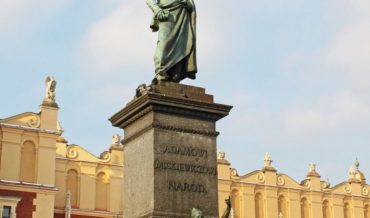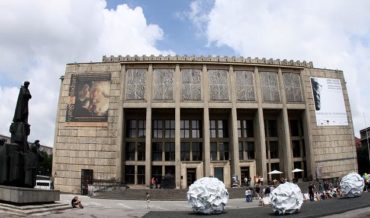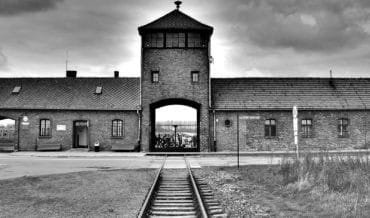Contents
- 1 Key Facts
- 2 Early Life and Artistic Formation (1875-1902)
- 3 International Education and Military Service (1902-1920)
- 4 Academic Career and Sculptural Innovation (1909-1944)
- 5 The War Years: Arrest, Survival, and Artistic Transformation (1940-1945)
- 6 Post-War Renaissance and Final Period (1945-1964)
- 7 Recognition, Collections, and Legacy
- 8 Artistic Philosophy and Enduring Influence
Key Facts
• Born in Krakow in 1875 and became one of Poland's most prominent sculptors of the 20th century
• Survived Auschwitz-Birkenau concentration camp after arrest by the Gestapo in 1940 at age 65
• Professor at three major art academies – Warsaw (1904-1909), Krakow (1909-1944), and Wrocław (1950-1964)
• Created the monument of Józef Dietl on All Saints Square in Krakow, unveiled in 1938
• Military service in French Foreign Legion during World War I and extensive studies in Paris
• Works displayed in major museums including National Museum in Warsaw and Krakow's National Museum
Early Life and Artistic Formation (1875-1902)
Xawery Dunikowski was born on December 24, 1875, in Krakow into a family that would nurture his artistic aspirations. His early education began at the Academy of Fine Arts in Krakow (1894-1902), where he studied under renowned sculptors including Alfred Daun and Teodor Rygier, who introduced him to both classical techniques and emerging modernist approaches.
During his student years, Dunikowski demonstrated exceptional talent in capturing human emotion through sculptural form. His early works, including student pieces still housed in the Academy's collection, showed a remarkable ability to synthesize academic training with personal artistic vision. This period established the technical foundation that would support his later innovations in Polish sculpture.
His graduation piece from the Krakow Academy received special recognition, marking him as one of the most promising sculptors of his generation and setting the stage for his future role as both artist and educator.
International Education and Military Service (1902-1920)
Paris Studies and European Influence
Following his graduation, Dunikowski traveled to Paris in 1902, where he studied at the École des Beaux-Arts and was exposed to the revolutionary sculptural work of Auguste Rodin. This Parisian period (1902-1904) was crucial in developing his modernist sensibilities, particularly his approach to surface treatment and psychological expression in sculpture.
During his time in Paris, he created several important works that demonstrated his synthesis of French modernist techniques with Polish cultural themes. His sculpture "Motherhood" (1903), now in the collection of the National Museum in Warsaw, exemplifies this period's artistic achievements.
World War I and Military Experience
The outbreak of World War I found Dunikowski in France, where he enlisted in the French Foreign Legion in 1914. His service, contrary to some accounts, lasted approximately eighteen months rather than six months, during which he served in various capacities including front-line combat roles.
This military experience profoundly influenced his artistic vision, introducing themes of human suffering, camaraderie, and resilience that would appear throughout his later work. Sketches from this period, preserved in the Dunikowski family archives, show his continued artistic practice even under wartime conditions.
Academic Career and Sculptural Innovation (1909-1944)
The Krakow Academy Period
Dunikowski began teaching at the Academy of Fine Arts in Krakow in 1909, not 1922 as sometimes reported. By 1916, he was appointed full professor, making him one of the youngest sculptors to achieve this distinction. His innovative teaching methods emphasized emotional expression over purely technical execution, revolutionary for academic art education of the era.
His student Józef Czapski (later a renowned painter and writer) documented Dunikowski's teaching philosophy, noting how the master encouraged students to find personal artistic voices while maintaining rigorous technical standards. The famous quote by student J. Bandura that "Xawery became such an inseparable element of Krakow's landscapes as the Florian's Gate" reflects his integration into the city's cultural fabric.
Major Sculptural Works of the Interwar Period
During the 1920s and 1930s, Dunikowski created his most celebrated public monuments:
The Józef Dietl Monument (1938) on All Saints Square represents his mastery of public commemorative sculpture. The work, commissioned by the Krakow city council, captures the reformist mayor's dynamic personality while demonstrating Dunikowski's ability to create psychologically complex portraiture on a monumental scale.
"Bolesław the Bold" (1930), located in Sandomierz, showcases his interpretation of Polish historical figures through modernist sculptural language. The work's dramatic composition and expressive surface treatment exemplify his mature style.
His Adam Mickiewicz commemorations series (various versions, 1920s-1930s), housed in multiple museum collections including the National Museum in Warsaw, demonstrates his approach to commemorating Poland's greatest romantic poet through intimate yet monumental portraiture.
The War Years: Arrest, Survival, and Artistic Transformation (1940-1945)
Arrest and Deportation
On May 18, 1940, Dunikowski was arrested during the Nazi "Sonderaktion Krakau" – the systematic roundup of Krakow's academic and intellectual elite. At age 64, he was initially sent to Sachsenhausen concentration camp before transfer to Auschwitz-Birkenau, where he remained until 1941.
His survival was aided by fellow prisoners who recognized his cultural importance and helped shield him from the most dangerous work details. Documentation from the Auschwitz-Birkenau Memorial and Museum archives confirms his prisoner number (4384) and his eventual release in 1941 due to international pressure and his advanced age.
Artistic Response to Trauma
The concentration camp experience fundamentally transformed Dunikowski's artistic vision. His post-war works incorporated themes of human dignity under extreme duress, spiritual resilience, and the capacity for both cruelty and compassion within human nature, representing important aspects of Jewish cultural heritage preservation.
Secret sketches he made during imprisonment, later discovered by researchers at the Institute of National Remembrance, show his continued artistic practice even under the most horrific conditions. These drawings, characterized by their stark emotional power, influenced his post-war sculptural style significantly.
Post-War Renaissance and Final Period (1945-1964)
Return to Teaching and Artistic Practice
Dunikowski resumed teaching at the Academy of Fine Arts in Krakow in 1945, bringing profound psychological depth to his pedagogy. Students from this period, including Magdalena Abakanowicz (who briefly studied with him), noted the philosophical dimension he brought to technical instruction.
In 1950, he moved to Wrocław to establish the sculpture department at the State Higher School of Fine Arts (now Academy of Art and Design), where he taught until 1960. This final teaching period was marked by his development of younger artists who would become major figures in post-war Polish art.
Later Masterworks
His post-war sculptural output included some of his most emotionally powerful works:
"Heads" series (1945-1955): These psychological portraits, including versions housed in the National Museum in Krakow, demonstrate his post-war preoccupation with human psychological states and spiritual endurance.
"Motherhood" variations (1950s): These works, building on his earlier explorations of maternal themes, incorporated his wartime understanding of protection, loss, and continuity of life, embodying the spiritual and cultural heritage that defines Polish artistic expression.
Recognition, Collections, and Legacy
Museum Collections and Exhibitions
Major museum collections housing Dunikowski's works include:
- National Museum in Warsaw: Comprehensive collection including early Parisian works and post-war sculptures
- National Museum in Krakow: Significant holdings including preparatory works for public monuments
- Museum of Sculpture in Królikarnia, Warsaw: Dedicated Dunikowski collection with rotating exhibitions
- Wrocław National Museum: Works from his final teaching period
International Recognition
His work has been exhibited internationally at major institutions including the Venice Biennale (1938 and 1956) and museums across Europe and North America. Art historians including Maria Poprzęcka (author of the definitive 1989 monograph on Dunikowski) have established his position as one of Central Europe's most significant 20th-century sculptors.
Urban Legacy in Modern Krakow
The Xawery Dunikowski Street in Nowa Huta honors his contribution to Polish culture. Additionally, the Dunikowski Museum, opened in 2018 in his former Krakow studio, preserves his workspace and displays rotating exhibitions of his lesser-known works, contributing to the broader network of art galleries that showcase the city's artistic heritage.
Contemporary sculptors continue to study his synthesis of emotional expression with technical mastery. His pedagogical methods, documented in the Academy of Fine Arts archives, remain influential in contemporary sculpture education throughout Central Europe and are part of Krakow's cultural history.
Artistic Philosophy and Enduring Influence
Dunikowski's artistic philosophy centered on sculpture's capacity to express profound human experiences through material transformation. His approach to teaching emphasized that technical skill must serve emotional and spiritual expression – a principle that influenced generations of Polish artists.
His integration of personal trauma with universal themes created works that speak to audiences across cultural and temporal boundaries. The psychological depth of his post-war portraits and the monumental dignity of his public works establish him as a master of 20th-century European sculpture.
Xawery Dunikowski died on January 26, 1964, in Warsaw, leaving behind a body of work that documents both personal artistic evolution and the broader Polish cultural experience through the century's most challenging periods. His sculptures continue to offer contemporary audiences insights into human resilience, the power of artistic vision to survive historical trauma, and the ongoing relevance of humanistic values in artistic expression.
Primary Sources and Collections:
- National Museum in Warsaw Digital Collection
- Academy of Fine Arts in Krakow Archives
- Auschwitz-Birkenau Memorial and Museum Documentation
- Institute of National Remembrance Archives
- Maria Poprzęcka, "Xawery Dunikowski" (Warsaw: Arkady, 1989)


